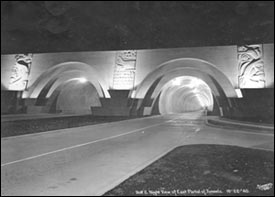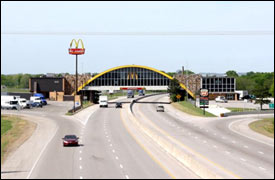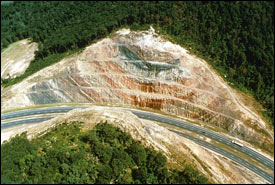















Successes in Stewardship: March 2007 |
|---|
 Topics: Interstate Highway System
Topics: Interstate Highway System
|
Federal Highway Administration
March 2007
Celebrating 50 Years of the Interstate



The Federal-Aid Highway Act of 1956 established the Dwight D. Eisenhower National System of Interstate and Defense Highways (Interstate System), connecting cities and states nationwide through a network of roadways, highways, bridges, and tunnels. The Interstate System created a network of roadways and increased mobility throughout the United States. In 2006, the Interstate System reached a significant milestone, celebrating an historic 50-year anniversary. Reaching this milestone also raised the potential for a large part of the Interstate System to be classified as historic property, which would make it subject to the regulations of Section 106 of the National Historic Preservation Act (NHPA) and Section 4(f) of the U.S. Department of Transportation (DOT) Act. These regulations require Federal agencies to take into account the effects of their undertakings on such properties before planning even the simplest construction or maintenance projects.
In 2005, the Advisory Council on Historic Preservation (ACHP) passed the Section 106 exemption, which exempts the majority of the Interstate System from being considered as an historic property under Section 106 of the NHPA. Section 6007 of the Safe, Accountable, Flexible, Efficient Transportation Equity Act: A Legacy for Users (SAFETEA-LU) also exempts the majority of the Interstate System as a historic property, under Section 4(f). While these two exemptions removed the majority of the Interstate System from the jurisdiction of Section 106 and Section 4(f), they also allowed for special features of the Interstate System to still be subject to historic preservation regulations. Section II of the Section 106 exemption allows for certain elements of the Interstate system, such as bridges, tunnels, and rest stops, to be excluded from the exemption if they have national and/or exceptional historic significance. Section 6007 of SAFETEA-LU also adopted the same exclusion provision for the 4(f) exemption.
In response to the regulatory exemption, the Federal Highway Administration (FHWA) created a process for determining which Interstate System elements would be excluded. To be considered for exclusion, an element has to meet at least one of these four sets of criteria:
FHWA and a team of Federal, state, and local stakeholders within each state used these criteria to establish a preliminary list of exclusions to the exemptions. The preliminary list was published in the Federal Register on June 16, 2006. FHWA received 55 sets of comments from state DOTs, state Historic Preservation Offices (SHPOs), state and local governments, transportation-related organizations, and other private groups and citizens. Most of the comments requested the addition or removal of specific elements, while others suggested changing the selection process, stating that the procedure was either too inclusive or too exclusive.
The next challenge for FHWA was to organize and address all of the comments it had received. For comments that could result in a possible revision to the exemption list, FHWA consulted with the team of representatives who helped to formulate the preliminary list, asking them to review the comments and working with them to revise the list as appropriate given the national perspective. In a continuing effort to keep the public involved in the decision-making, in states where an element was being considered for addition to or removal from the list, the process included any stakeholders who had submitted comments.
During the comment period, 26 elements were removed from the preliminary list and six were added. The Final List of Nationally and Exceptionally Significant Features of the Federal Interstate Highway System, published in the Federal Register on December 19, 2006, included 132 features to be excluded from the Section 106 and Section 4(f) exemptions. These exceptional elements include 81 bridges, 22 highway segments, and 13 tunnels among other unique resources such as rest areas and parks.
The process of finalizing the exemption list illustrates the teamwork and coordination that goes into a public historic preservation project. For more information on the Interstate Exemption, please view the Successes in Stewardship May 2005 issue on Section 106, the February 2006 issue on SAFETEA-LU, and the FHWA Interstate Highway website.
For property being considered for the National Register of Historic Places, the following questions can determine eligibility:
Unless there is some exceptional reason, properties that are considered eligible usually exclude cemeteries, birthplaces, graves of historical figures, religious structures, structures that have been moved from their original location, reconstructed historic buildings, commemorative properties, and properties that have achieved significance within the past 50 years. For more information on how to list a property, visit the National Register website.
|
MaryAnn Naber Federal Preservation Officer FHWA Office of Project Development and Environmental Review 400 Seventh Street, SW Room 3222 Washington, DC 20590 202-366-2060 MaryAnn.Naber@dot.gov |
Look What's New!Visit the new SAFETEA-LU webpage for guidance and information on SAFETEA-LU environmental provisions. The webpage includes an Environmental Review Process Toolkit, with examples of the SAFETEA-LU Environmental Review Process implementation. |
"Successes in Stewardship" is a Federal Highway Administration newsletter highlighting current environmental streamlining and stewardship practices from around the country. To subscribe, visit the Registration Site, or call 617-494-3137. |
